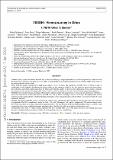VISION - Vienna survey in Orion. I. VISTA Orion A Survey
Abstract
Context. Orion A hosts the nearest massive star factory, thus offering a unique opportunity to resolve the processes connected with the formation of both low- and high-mass stars. Here we present the most detailed and sensitive near-infrared (NIR) observations of the entire molecular cloud to date. Aims. With the unique combination of high image quality,survey coverage, and sensitivity, our NIR survey of Orion A aims at establishing a solid empirical foundation for further studies of this important cloud. In this first paper we present the observations, data reduction, and source catalog generation. To demonstrate the data quality, we present a first application of our catalog to estimate the number of stars currently forming inside Orion A and to verify the existence of a more evolved young foreground population. Methods. We used the European Southern Observatory's (ESO) Visible and Infrared Survey Telescope for Astronomy (VISTA) to survey the entire Orion A molecular cloud in the NIR J, H, and KS bands, covering a total of ~18.3 deg2. We implemented all data reduction recipes independently of the ESO pipeline. Estimates of the young populations toward Orion A are derived via the KS-band luminosity function. Results. Our catalog (799 995 sources)increases the source counts compared to the Two Micron All Sky Survey by about an order of magnitude. The 90% completeness limits are 20.4, 19.9, and 19.0 mag in J, H, and KS, respectively. The reduced images have 20% better resolution on average compared to pipeline products. We find between 2300 and 3000 embedded objects in Orion A and confirm that there is an extended foreground population above the Galactic field, in agreement with previous work. Conclusions. The Orion A VISTA catalog represents the most detailed NIR view of the nearest massive star-forming region and provides a fundamental basis for future studies of star formation processes toward Orion.
Citation
Meingast , S , Alves , J , Mardones , D , Teixeira , P S , Lombardi , M , Großschedl , J , Ascenso , J , Bouy , H , Forbrich , J , Goodman , A , Hacar , A , Hasenberger , B , Kainulainen , J , Kubiak , K , Lada , C , Lada , E , Moitinho , A , Petr-Gotzens , M , Rodrigues , L & Román-Zúñiga , C G 2016 , ' VISION - Vienna survey in Orion. I. VISTA Orion A Survey ' , Astronomy & Astrophysics , vol. 587 , A153 . https://doi.org/10.1051/0004-6361/201527160
Publication
Astronomy & Astrophysics
Status
Peer reviewed
ISSN
0004-6361Type
Journal article
Description
Stefan Meingast is a recipient of a DOC Fellowship of the Austrian Academy of Sciences at the Institute for Astrophysics, University of Vienna. H. Bouy is supported by the the Ramón y Cajal fellowship program number RYC-2009-04497 and by the Spanish Grant AYA2012-38897-C02-01.Collections
Items in the St Andrews Research Repository are protected by copyright, with all rights reserved, unless otherwise indicated.

